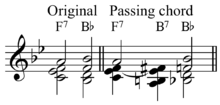|
Passing chord  In music, a passing chord is a chord that connects, or passes between, the notes of two diatonic chords.[3] "Any chord that moves between one diatonic chord and another one nearby may be loosely termed a passing chord. A diatonic passing chord may be inserted into a pre-existing progression that moves by a major or minor third in order to create more movement."[4] "'Inbetween chords' that help you get from one chord to another are called passing chords."[5] For example, in the simple chord progression in the key of C Major, which goes from Imaj7/iii7/ii7/V7:[4] |Cmaj7 |Em7 |Dm7 |G7 | the diatonic (this means "from the scale of the tonic") passing chord (Dm7) may be inserted: |Cmaj7 Dm7 |Em7 |Dm7 |G7 | or the chromatic passing chord (Ebm7) may be inserted: |Cmaj7 |Em7 Ebm7 |Dm7 |G7 | or one or more secondary dominants may be inserted: |Cmaj7 B7 |Em7 A7 |Dm7 |G7 | (in this example, the B7 is the secondary dominant of Em7 and the A7 is the secondary dominant of Dm7) A chromatic passing chord is, "a chord that is not in the harmonized scale"[6] For example, one or more diminished seventh chords may be inserted: |Cmaj7 D# dim7' |Em7 C# dim7 |Dm7 |G7 | (in this example, the D# dim7 is the viio7 of Em7 and the C# dim7 is the viio7 of Dm7) Passing chords may be consonant or dissonant[7] and may include flat fifth substitution, scalewise substitution, dominant minor substitution, approach chords, and bass-line-directed substitution.[5] Passing chords may be written into a lead sheet by a composer, songwriter, or arranger. As well, particularly in smaller ensembles, such as the organ trio or jazz quartet, the comping (chord-playing) rhythm section instrumentalists (e.g., jazz guitar, jazz piano, Hammond organ) may improvise passing chords. With large ensembles, such as a big band, the comping players may have less freedom to improvise passing chords, because the composer/arranger may have already written in passing chords into the written horn parts, which might clash with improvised passing chords played by a comping musician. The freedom of comping musicians to improvise passing chords also depends on the tempo. In a very slow ballad, if a chord-playing musician adds in an improvised diminished chord for a half a bar, this may "clash" with the melody notes or chords played by other performers. On the other hand, in an extremely up-tempo (fast) bebop tune, a comping musician could add improvised passing chords with more freedom, because each bar goes by so fast. See alsoReferences
Further reading
|
